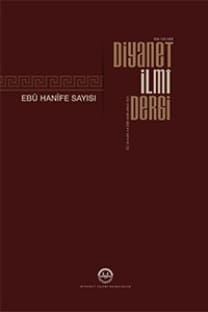FÂRÂBÎ'NİN İLİMLER TASNİFİNİN LATİN DÜNYASINA GEÇİȘİ VE KABULÜ
Bilindiği gibi Fârâbî, ilimler tasnifine devraldığı felsefi mirasın etkisiyle olduğu kadar İslam düşüncesinin kendi iç dinamiklerinin de etkisiyle ayrı bir önem vermiş ve ilimler tasnifi için müstakil ve oldukça değerli bir eser yazmıştır: İḥṣâul-ulûm. Grek felsefesinin bir devamı olarak, ilimler tasnifinin Aristo ve Porphyriustan intikal eden mirası Fârâbîde dikkate değer bir değişime uğramıştır. İslam düşüncesinde ardılları tarafından önemli ölçüde benimsenen Fârâbî ilimler tasnifi, XII. yüzyılda İbranice ve Latince olmak üzere Batı dünyasına üç ayrı çeviri ile intikal etmiştir. Dominic Gundissalinus 1140larda eserin önemli bir kısmını De Scientiis adı altında felsefenin kısımları (De Divisione philosophiae) olarak, Gerard of Cremona ise De Divisione Scientarum adıyla 1175lerde çevirmiştir. Üçüncü çeviri ise Avendauth (Ebu Davud)a atfedilmiştir. Bu makalede Fârâbîden Latin dünyasına intikal eden eserin yukarıda zikredilen ilk iki çeviri yoluyla etkileri üzerinde durulmaktadır. Elverdiği ölçüde Gundisalvinin ilimler tasnifiile de bir karşılaştırma yapılmaktadır.
THE INTRODUCTION OF FÂRÂBÎ S THE CLASSIFICATION OF SCIENCES TO LATIN WORLD AND THEİR ACCEPTANCE
Influenced by both the ancient philosophical heritage he inherited and the internal dynamics of the Islamic thought, al-Fârâbî attached particular importance to the classification of sciences and wrote an independent and invaluable work on it: İḥṣâʾ al-ʿUlūm (The Enumeration of the Sciences). The Greek tradition of classification of sciences coming down from Aristotle and Porphyry underwent a remarkable change at the hands of al-Fârâbî. Al-Fârâbî s classification, which was appropriated to a great extent by his successors in the Islamic thought, was made available to the West in the 12th century in three translations, two in Latin and one in Hebrew. Dominicus Gundissalinus, who translated an important portion of the work under the title De scientific as divisions of philosophy (De divisione philosophiae) in the 1140s, was followed by Gerard of Cremona, who translated it under the title De divisione scientarum around 1175. Their contemporary translation is ascribed to Avendauth. This paper focuses on the in fluence of al-Fârâbî s work in the Latin world through the first two translations mentioned above. It also attempts to make a comparison between al-Fârâbî s classification of sciences and Gundissalinus classification.
___
- Aristoteles, Metaphysics, The Complete Works Of Aristotle, vol. II, edit. Jonathan Barnes, Princeton University Press, 1995.
- Drant, Edward, A source Book in Medieval Science, edit. Edward Drant, Harward University Press, Cambridge, Massachusetts 1974.
- Aydınlı, Yaşar, Fârâbî, İSAM Yay., İstanbul 2008.
- Bakar, Osman, Gelenek ve Bilim, çev. Ercüment Asil, Gelenek Yayınları, İstanbul 2003.
- _______, İslam Düşüncesinde İlimlerin Tasnifi, çev. Ahmet Çapku, İnsan Yay., İstanbul 2012.
- Bouyges, Maurice: (Notes sur les philosophes arabes connus des Latins aumoyen age.) VII: Sur le De Scientiis dAlfarabi récemment édité enarabe à Saïda et sur le de Divisione Philosophiae de Gundissalinus.Mélanges de IUniversité Saint-Joseph (Beirut) 9.1923-24, Islamic Philosophy, vol. IX, pp.1-23.
- Camerarius, Guilelmus (Ed.): Alpharabii, vetustissimi Aristotelis interpretis opera omnia, guae, latina linguâ conscripta reperiri potuerunt. Paris 1638. Bkz. Islamic Philosophy, vol. VII.
- Constant J. Mews Questioning the Music of the Spheres in Thirteenth-Century, Studies Und Texte Zur Geistesgeschicte, edisyon Joseph Canning, Edmund King ve Martial Staub, Brill 2011.
- Gundisalvo, Domingo, Classification of The Sciences, İngilizceye çeviri Marshall Clagett ve Edward Grant, Notlarla Neşreden Edward Grant, A Source Book in Medieval Science edit. Edward Drant, Harward University Press, Cambridge, Massachusetts 1974.
- el-Endelüsî, Sâid, Tabakâtul-ümem, el-Matbaatul-Kâtûlîkiyye, Beyrut 1912. Fârâbî, et-Tenbîh alâ sebîlis-saâde, thk. Cafer Âli Yâsin, Hikmet, İran 1371.
- _______, İlimlerin Sayımı, çev. Ahmet Arslan, Vadi Yay., Ankara 1999.
- _______, İhsâul-ulûm, notlarla neşreden Osman Zeki, Kahire 1949.
- _______, İhsâul-ulûm (İlimlerin Sayımı), çev. Ahmet Ateş, MEB Yay., İstanbul 1989.
- _______, İḥṣâul-ulûm, notlarla nşr. Ali b. Mulhim, Dârul-Mektebetil-Hilâl,1996.
- _______, Risâle fî fazîletil-ulûm ves-sınaât, Resâil, nşr. Dietrici, Dâire-tul-Maârifil-Osmaniye Haydarâbâd 1345
- Farmer, Henry G., Al-Fārābīs Arabic-Latin Writings on Music in the Ih-sāal- ulūm, Glasgow: The Civic Press, 1934.
- _______, The Influence of Al-Farabis Ihsa al-ulum (De scientiis) on the writers on Music in Western Europe, The Arabian Influence on Musical Theory, Cambridge 1932.
- Fidora, Alexander, Dominicus Gundissalinus and the Introduction of Metaphysics into the Latin West, The Review of Metaphysics, 66 (2013).
- Grant, Edward, The Foundations of Modern Science in the Middle Ages, Cambridge University Press 1996.
- _______, Classification of the Sciences, A Source Book in Medieval Science, edit. Edward Grant, Harward University Press, Cambridge, Massachusetts 1974.
- Sezgin, Fuat, Islamic Philosophy, vol. IX, Frankfurt 1999.
- Ross, David, Aristotales, çev. Ahmet Arslan, Kabalcı Yayınevi, İstanbul 2002.
- Salman, Dominique, The Medieaeval Latin Translations of Alfarabis Works, İslamic Philosophy, vol. IX, edit. Fuat Sezgin, Frankfurt 1999.
- Schneider J.H. Josef, Philosophy and Theology in the Islamic Culture: Al-Fārābīs De scientiis, Philosophy Study, June, 2011.
- Thompson, J.W., The Introduction of Arabic Science into Lorraine in the 10th Century, ISIS içinde, vol. XII, 1929.
- Williams J. Steven, The Secrets of Secrets: Scholarly Career of A Pseudo-Aristotelian Text in The Middle Ages, The University of Michigan Press, 2003.
- ISSN: 1300-8498
- Yayın Aralığı: Yılda 4 Sayı
- Başlangıç: 1956
- Yayıncı: -
Sayıdaki Diğer Makaleler
FÂRÂBÎ DÜȘÜNCESİNDE İLÂHÎ CÖMERTLİK (CÛD) VE ADALET (ADL)
EBÛ NASR EL-FÂRÂBÎ’DE FELSEFÎ ANTROPOLOJİNİN PSİKO-METAFİZİK TEMELLERİ
FÂRÂBÎ'NİN TEVHİD ANLAYIȘI VE SIFATLAR MESELESİ
GÜNÜMÜZE ÖRNEKLİĞİ AÇISINDAN FÂRÂBÎ'NİN VİZYONU
FÂRÂBÎ'DE TÜMELLERİN VARLIKLA ÖNCELİK, BERABERLİK VE SONRALIK İLİȘKİSİ
FÂRÂBÎ’NİN EL- HALÂ' YAZISI ÜZERİNE BİR DENEME
FÂRÂBÎ'NİN KİTÂBU ÎSÂGÛCÎ EY EL-MEDHAL ADLI ESERİ
